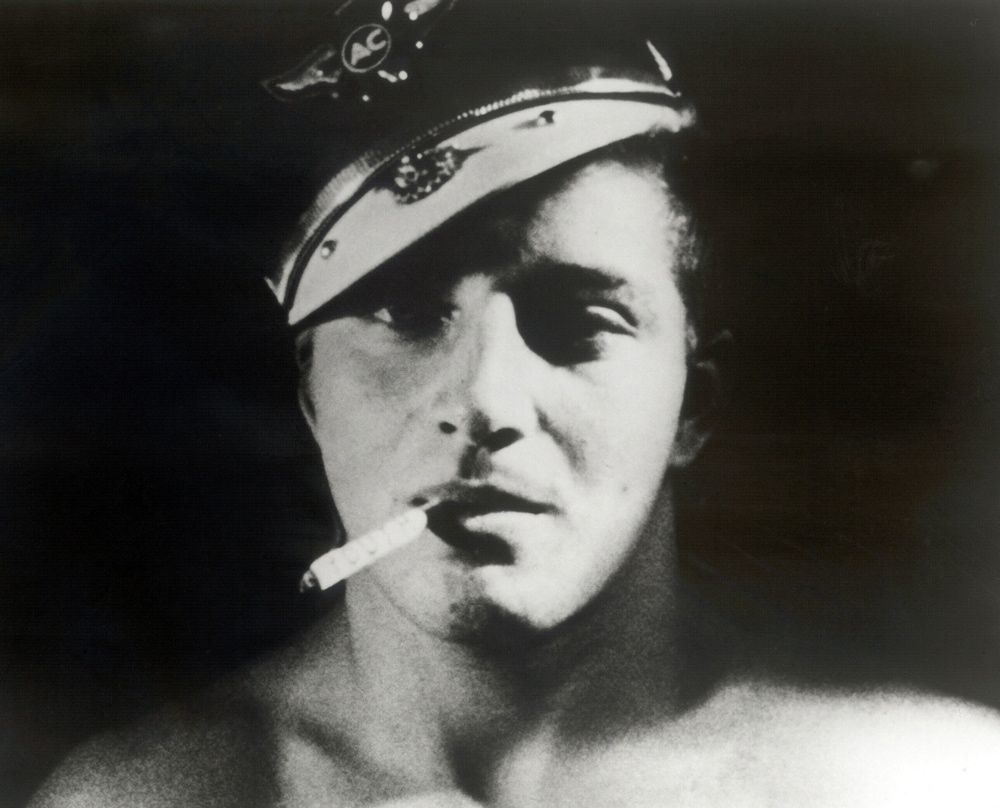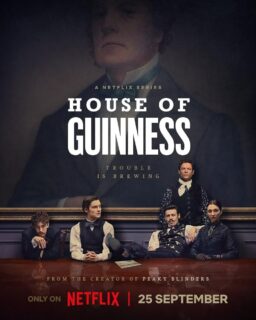A world without Kenneth Anger is a poorer place. The queer filmmaker, fanatic, mythmaker, and gadfly was like the anti-Charles Chaplin. The two made headlines in very different ways. The two spanned crucial decades of Hollywood history and left their mark on it. Their films became exemplars of a particular form, Chaplin the silent comedy, Anger homoerotic experimental postmodernism. Chaplin was like a king, a man beloved and gossiped about who became immortal. Anger would have loved to be thought of that way but he achieved something more interesting and deviant; Anger was like the devil in the flesh, a creature of underworld class and occult danger, a man who made trouble just by being who he was. Anger never became a star, exactly, but he became infamous and never compromised who he was. He lived to become your favorite filmmaker’s favorite filmmaker as the world grew to resemble his fabled Hollywood in all but its aesthetic.
Kenneth Anglemyer was born in 1927 in Santa Monica, the youngest of three children. His siblings would recall that Kenneth, the miracle child, was spoiled by his mother and it turned him bratty, selfish, and more than a little helpless. His home life, according to Anger, wasn’t particularly warm. His mother moved in with a female friend when he was young, and though he remembered his mother’s companion, Miss Diggy, as being supportive, it was also young Kenneth’s first brush with scandal, something that would come to define his life as much as his art. His fascination with film started very early. His mother took him to a fateful double of bill of Lloyd Bacon’s “The Singing Fool,” an Al Jolson-starring follow-up to his 1927 movie “The Jazz Singer,” the first of the major talkies, and “Thunder over Mexico,” a film edited out of Sergei Eisenstein’s oneiric unfinished odyssey “¡Que Viva Mexico!”.
Kenneth’s grandmother, “Big” Berta, was a ‘wardrobe girl’ and regaled Kenneth with stories of Hollywood drama. His mother supported his young dreams of stardom (which manifested in his frequently dressing up in old gowns left in the attic), taking him to auditions and helping him possibly land a part in a 1935 production of “A Midsummer Night’s Dream” directed by William Dieterle. Anger’s biographer Bill Landis says this definitely happened, but like much of his accomplishments, there’s quite a bit of contention about whether it did. One thing is certain: he did make friends with “Midsummer” star Mickey Rooney, and he had to have met him somewhere. He also claims to have met Shirley Temple and danced with her at a cotillion. He was reportedly quite put out that he failed to become a child star like Temple or Rooney.
Anglemyer started directing his own movies, many of them flirting with experimental montage (he discovered and fell in love with the work of Jean Cocteau, who later became a friend) before he was old enough to drive. He met like-minded memorabilia and history nut Curtis Harrington, who, like Rooney, became a lifelong friend and, like Kenneth, became an experimental filmmaker. Harrington would represent the never-was of Kenneth’s own artistic life; where Kenneth refused to make movies that were anything but a reflection of his dreams, his urges, and his fetishes, Harrington eventually learned to play ball and start directing movies that would be palatable to the broadest audience possible.
The two created a small group called The Creative Film Associates to distribute their work as well as that of other California-made non-narrative films, and they started sharing their favorite works by famous supposed devil-worshippers like Aleister Crowley and Joris-Karl Huysmans. Anglemyer idolized Crowley, the kitschy self-styled anti-Christian, like a rock star. His money, what little of it there was (his grandmother paid for his lifestyle), went to his art projects and drugs while he studied film at the University of Southern California. In 1947, at age 20, he made his first landmark movie, the heaving daydream “Fireworks,” the first film to be released under his new name. Kenneth Anglemyer was no more. Kenneth Anger had been born.
“Fireworks,” the first of nine movies in what he would later call his Magick Lantern Cycle, features the director playing a thinly veiled version of himself, a gay outsider struggling with imagined sexuality. He was a shy and thin man, a small presence in rooms despite his massive height and stern looks. He’s a figure of tragic sexuality out of Cocteau, watching sailors flex their muscles and overpower him physically. Sexuality was a curious, sometimes painful thing for Anger. He had been arrested in a sting for cruising in the ‘40s, and “Fireworks,” a film that frequently seems like a confession and meditation on this traumatic event, brought Anger to a Los Angeles court on obscenity charges. The Supreme Court eventually ruled in his favor: this was art, not smut. Just like that, Anger knew he was free to be who he wanted in his art … if there was financial support, of course.
The film’s stunning, stark images of defiled, bloody bodies and gleaming white surfaces (sailor suits, bare chests, milk poured over Anger’s own body in a ritual partway between ejaculation and purification) in need of defacement was a first for the American cinema, even in the realms of the avant-garde. America had no Cocteau figure who could proudly display the things that turned them on and haunted them with equal fervor. Anger was happy to be that figure.
Tennessee Williams and Anaïs Nin were moved by it, as was Cocteau, who sent him a letter to congratulate him on his achievement. Anger’s follow-up was the remarkable “Puce Moment,” which found him reliving his days of playing dress up in the attic with old flapper gowns. A woman frolics about in her home, smiling, projecting a kind of freedom through her flouncing movements and a surfeit of fancy clothes. The film is like an ecstatic answer to the menace of the work of the great feminist experimental filmmaker Maya Deren, whose movies brim with portent and the threat of the end of Deren’s own freedom.
Anger, aware that his career as an artist wasn’t going to get off to the start he hoped, left for Paris, where he spent much of his time hanging with Cocteau and working for Henri Langlois at La Cinémathèque française (Langlois gifted Anger with reels from Eisenstein’s “¡Que Viva Mexico!” bringing the young man’s love of cinema full circle). His parents cut off his allowance in 1950, hoping to force him back to the States, but the ploy didn’t work. He remained in Europe until his mother’s death in 1953, making and abandoning projects in France and Italy.
His gorgeous 20-minute short “Rabbit’s Moon” was meant to be longer, but he snuck onto a soundstage at Films du Pantheon Studio and was caught before he could finish working. A proposed project about a famous occultist, cardinal D’este, was winnowed down to the 12-minute “Eaux D’Artifice.” Much of Anger’s work during this period would not be completed and shown until much later.
Back in the States, he befriended one of his acolytes, experimental pioneer Stan Brakhage; they attempted to collaborate, but the negatives were confiscated when neither paid the development fees. He made the half-hour “The Inauguration of the Pleasure Dome” in 1954, starring his friends, including Marjorie Cameron, the widow of rocket engineer Jack Parsons. Parsons, like Anger, was a convert to Aleister Crowley’s Thelemite religion and an important figure of American occultism. The film was a gorgeous, dreamy drift through costumed gods, faces, and images of animals and grams as Crowleyian occult symbols assail his characters. When Anger died on the 24th of May 2023, the critic Adam Piron lamented that Anger was “one of the few to understand cinema as ceremony.” “Inauguration,” like the best of Anger, seems like an induction into his arch-belief system and its pagan worship rather than merely a collection of stunningly strange pictures of demigods drinking deeply and wandering through purgatory.
In 1955, feeling despondent after the death of his friend Thomas Kinsey, the sex researcher, Anger returned to Paris for a spell of isolation. Out of money and with no movie on the horizon, he reached out to Cahiers du Cinema, the French film criticism magazine, and offered to write them stories he had heard about Hollywood history. The more he wrote, the more his editors thought a better outlet for these tall tales was a book, and so was born Hollywood Babylon, published in 1959 in France and a few years later in the States. Film historian Kevin Brownlow represented the point of view of people who had done hard research on the first few decades of Hollywood history when he said that Anger’s research must have consisted of “telepathy.” Maybe nothing in Anger’s book happened the way he said it did, but, like his movies, it’s a window into a satanic alternate reality and much more fun to believe than the truth. As Michael Sicinski put it when Anger died: “Everything he did was about the “dream factory” as suppression of our darkest urges. Sometimes this manifested as petty vindictiveness, but more often it was luminescent queer poetry.”
There’s little denying the insouciant thrill of Anger’s prose: “In a few years of churning out primitive and profitable two-feelers with their pirated cameras—always on the lookout for Edison’s vengeful process servers—the former junk dealers and gloves salesmen juggled a chancy operation in a celluloid bonanza.” “The fans worshipped, but the fans also could be fickle, and if their deities proved to have feet of clay, they could be cut down without compassion. Off screen a new Star was always waiting to make an entrance.”
Hollywood, in Anger’s telling, was a neverending orgy of drugs, sex, and murder, and his embellishments made a sordid place seem like hell on earth. Stories of Ramon Novarro being choked to death with a dildo, Bugsy Siegel blackmailing studios for money to run a white slavery ring, or Lionel Atwill trying to get Douglas McArthur’s ex-wife to incorporate a live snake into their sex play are borderline surreal, but they were more popular than the facts, which were only a shade less depraved than Anger’s anyway. People love stories of the wealthy and powerful degrading themselves as much as they enjoy their movies and star images, and Anger was just one of the first people to realize there was money and power to be had in dragging them through the mud. Infamy, as always, came easier to Anger than an honest day’s work. And it was so much more fun.
Anger returned to the States in the ‘60s, looking to restart his artistic career. He was living with the filmmakers Marie Menken and Willard Maas when he noticed the bikers who would gather at Coney Island; they were his kind of people. He photographed them and their bikes before deciding he had a more concrete idea. He started filming scenes of a biker named Bruce Byron, calling the film “Scorpio Rising” after Byron’s astrological sign. Anger intercut footage of Bruce dressing and undressing, bikers working on their choppers and a symbolic orgy scene with scenes of Nazis and Jesus Christ. The film was confiscated during a screening (Anger claimed the American Nazi Party called in the raid) and offended everyone from bikers to prudes. The film’s use of pop music influenced a generation of directors for whom the idea of mixing pop music and abstraction would have seemed impossibly transgressive. Soon after, John Waters started putting rock and roll in his early features “Mondo Trasho” and “Multiple Maniacs,” then Martin Scorsese followed with “Mean Streets,” and then everyone was doing it. The fetishized and exotic images of bikers seem to have influenced everyone from David Lynch to Kathryn Bigelow to George A. Romero to Walter Hill.
Anger pulled off the impossible with his next film when he scored a $10,000 grant from The Ford Foundation, but immediately shot himself in the foot (or maybe did exactly what he meant to do) when he started giving interviews about how much the movie was going to piss them off. True to his promises, it did. The three-minute short “Kustom Kar Kommandos” is a series of glamorous images of someone buffing a beautiful old (and, let’s face it, erotic) car while “Dream Lover” by The Paris Sisters plays on the soundtrack. Like a lot of Anger’s work, it is now seen as a precursor to the modern music video, which grew popular just as Anger’s output was slowing and his image softening.
By the late ‘60s, Anger was as much a cultural fixture as any rock star, and his list of famous friends was growing. He started prepping for his newest film, “Lucifer Rising,” by tattooing “Lucifer” on his chest. It was to star musician Bobby Beausoleil, but between the two’s contentious relationship and Beausoleil’s murder charge (he killed fellow cultist Gary Hinman at the behest of Charles Manson), they never finished the movie (though the two eventually reconciled while Beausoleil was in prison). He recycled the footage into a new work called “Invocation of My Demon Brother” and then tried to remake “Lucifer” later with a score by Jimmy Page of Led Zeppelin. Ever the people-pleaser, Anger fell out with Page over his girlfriend and threatened to put a hex on him. Marianne Faithful headed up the cast of the reimagined “Lucifer Rising,” first finished in the early ‘70s, though Anger tinkered with it repeatedly. It’s a film perfectly in line with the era’s visual psychedelia (to the shock of no one, his movies had become popular screening choices for audiences tripping acid), a wonderfully lithe survey of Thelemite images and occult suggestion, and could easily have filled out double bills with the likes of Alejandro Jodorowsky’s “The Holy Mountain” or Michelangelo Antonioni’s “Zabriskie Point.”
Anger didn’t make a single movie between “Lucifer Rising” and “Don’t Smoke That Cigarette” in 1999. When interviewed for a PBS special about his life and art, he told the interviewer he was so broke he had to sell his air conditioner. He had written a sequel to Hollywood Babylon in 1984, but the response wasn’t as great. As with many provocateurs, including Waters and Andy Warhol, who Anger despised, staying relevant can become very difficult once your art has broken boundaries and changed tastes. Anger didn’t quite manage, aging into a slightly more benevolent version of the acidic hell-raiser he so gleefully played for decades.
Anger’s last decade of movies seemed less personal, some financed by his old friend Paul Getty, heir to the Getty millions who he met during his heyday roving around London looking for stars and money to make “Lucifer Rising.” Movies like “Elliott’s Suicide,” “Mouse Heaven,” and “The Man We Want to Hang” lamented old friends and kindred spirits passing. Anger died in an assisted living facility after many years as a neglected valedictorian, a hellion the culture had outgrown as he spurned it from his diminished place.
Anger was one of the most singular American artists of the 20th century. If he had stopped after “Scorpio Rising” or had only made “Fireworks,” he would still be in textbooks. But he lived a life as wild, woolly, fast, sensuous, and dangerous as any of his movies. A film by Anger promised heat, dirt, leather, glimmering surfaces, the devil winning a battle with God, sex and brutality, and hidden messages to the faithful who could be right beside you in the theatre. Anger spoke to a cultural niche that became greater than he could have imagined. He created a world of satanic rituals and sexual release splitting out of leather onto the hood of a speeding car. It was little wonder a man like that, who hardly seemed capable of keeping his soul inside his body, could not find a permanent place in our world except as an idea, a suggestion, the promise of something deeply, deliciously wrong.












